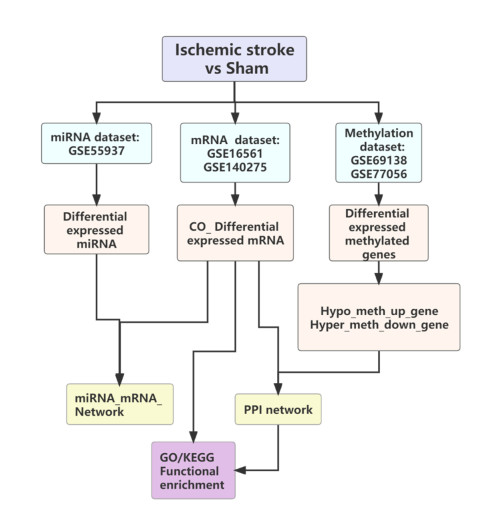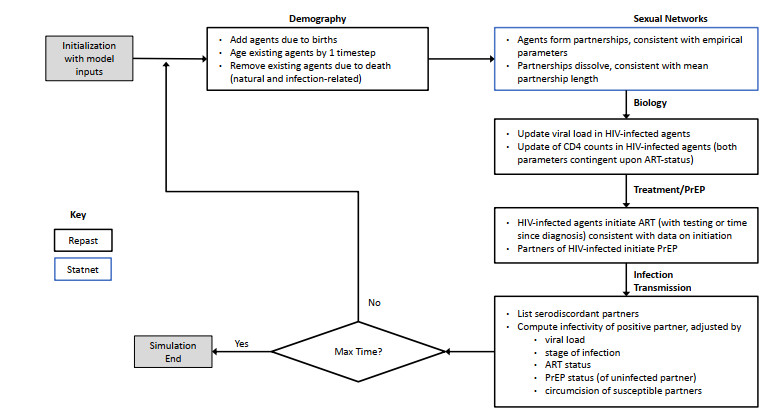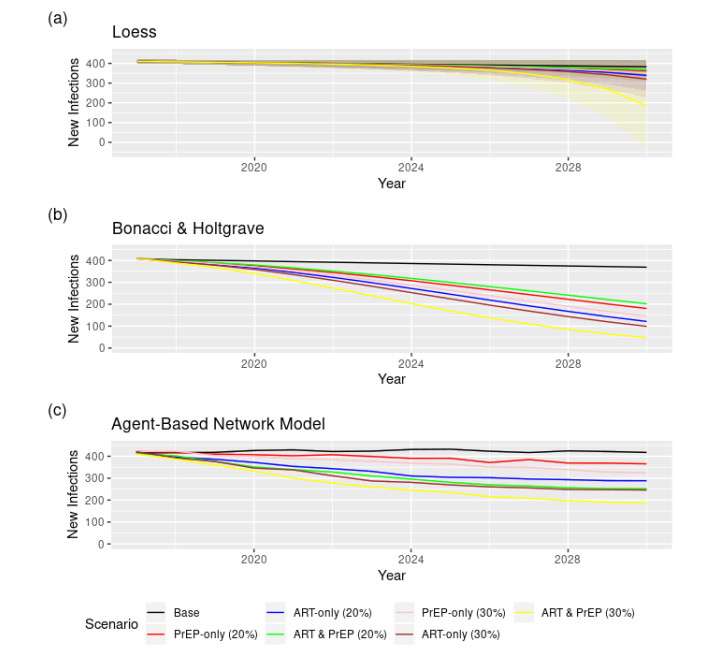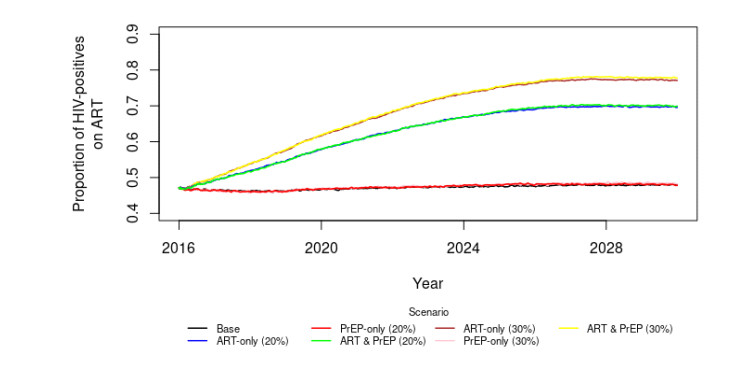1.
Introduction
Stroke, also known as cerebral apoplexy, is a brain disease caused by obstruction of blood drainage and poor blood flow to the brain and is among the leading causes of mortality and disability [1,2,3,4,5]. An inadequate supply of oxygen and nutrient-rich blood to the brain can lead to reduced blood flow and cell death. Strokes have two main subtypes: ischemic stroke (IS) due to lack of blood flow, and hemorrhagic stroke (hemorrhagic stroke) develops due to bleeding [6,7]. Ischemic stroke accounts for about 80% of the 780,000 new stroke cases worldwide, making stroke one of the deadliest diseases [8,9]. Stroke is the third major cause of disability worldwide and the second leading mortality factor following ischemic heart disease [10]. With the onset of stroke, the patient requires long-term follow-up and medication, which imposes a substantial mental, financial and time strain. Several risk factors have been found, including smoking, diabetes, hyperlipidemia and hypertension. However, the precise molecular pathways underlying IS have not been fully elucidated. A broader literature hailed early IS diagnosis as an improvement factor in patient outcomes [11]. Although mainstay treatment approaches for acute ischemic stroke (AIS) have improved survival, narrow treatment time windows have prompted researchers to search for new treatments [12,13,14,15,16]. This information demonstrates the urgency and significance of elucidating the underlying mechanisms of IS to probe the novel biomarkers and therapeutic targets.
MicroRNAs (miRNAs) is a class of small RNAs constituting about 22–24 conserved nucleotide sequence, which may couple to its target complementary messenger RNAs (mRNAs) sequences. Generally, miRNAs are post-transcriptional regulators of translation or target mRNA degradation [17]. A single miRNA may regulate multiple target genes, and a single gene can be regulated by multiple miRNAs [18]. Over 2,000 miRNAs are identified in humans, which are presumed to regulate approximately 33% of human genes [19]. Therefore, changes in miRNAs can influence many diseases. Multiple research hailed miRNAs as fundamental constituent to play imperative organic roles in cell development, expansion, differentiation, apoptosis and remodeling of damaged and healthy tissue [20,21].
Recent advents in research techniques have led to a thorough understanding of the relationship between epigenetics and disease. DNA methylation has been identified as a key area of epigenetics [22], and it is most prevalent on the CpG islands, basically in the human genome's proximal promoter regions [23], which changes an individual's natural function by directing gene expression or genomic stability [24]. Two gene promoters can be protected from transcription factors, which hamper the bindings of transcription factor binding and modify chromatin structure. Gene promoters are fundamental cis-acting regulatory elements in gene expression initiation and regulation [25]. DNA methylation takes place and, in some instances, can even be detected before disease manifestation. This vital finding in the current study proposes DNA methylation to be utilized as a marker for the early screening of fundamental infections [26]. Therefore, studying differential DNA methylation sites is of great significance for early screening and treatment of IS.
In this study, we examined differentially expressed miRNAs, differentially expressed genes and differential DNA methylation sites obtained between ischemic stroke patients and healthy controls based on five published gene datasets in the GEO database. Furthermore, we identified the protein-protein interaction network of differentially DNA-methylated genes in IS by DNA methylation analysis and identified a potential differentially expressed miRNA-target gene regulatory network.
2.
Materials and methods
2.1. Data sources and preprocessing
The unstandardized Series Matrix File of the corresponding dataset was downloaded from Gene Expression Omnibus (GEO, http://www.ncbi.nlm.nih.gov/geo/). Differential analysis was performed to elucidate the ischemia DNA methylation and (miRNA-mRNA)regulatory network in stroke. The miRNA data of GSE55937 was generated from GPL163845, including 24 IS and 24 control samples. Gene expression data included the GSE16561 dataset from GPL6883 and the GSE140275 dataset from GPL16791. The GSE16561 dataset includes 39 IS samples and 24 control samples. The GSE140275 dataset includes 3 IS samples and 3 control samples. The obtained expression data were quantile normalized [28] using Limma [27] package (limma_3.50.3). At that point, log2 logarithmic change is performed to get the gene expression network of the test group finally. DNA methylation data includes the datasets GSE69138 and GSE77056 generated from GPL13534. IS and control samples were unavailable in the same dataset. Thus, we combined 404 IS samples from GSE69138 and 24 control samples from GSE77056.
2.2. Sample correlation analysis
Principal Component Analysis (PCA) algorithm reduces the data dimension in an unsupervised feature learning and classifies data based on the expression of samples. PCA analysis was used to reduce the dimension of the data, and the intuitive distribution of samples between the control and experimental groups was obtained. We used the genes exhibiting the significant mean difference (ANOVA) across all samples (P value < 0.05) for PCA analysis and drew the PCA map (all genes were used for the PCA map without repeated samples).
2.3. Differentially expressed gene screening
The samples were grouped, and the differentially expressed miRNAs and mRNAs were calculated using the R package Limma [27]. The threshold was set as |log2(Fold Change)| > 1.2 and P-value < 0.05 to screen differentially expressed miRNAs. Next, the GSE16561 dataset was analyzed with |log2(Fold Change)| > 1.2 (P-value < 0.05) as a threshold to screen DEGs. The GSE140275 dataset screened DEGs by |log2(Fold Change)| > 1.5 and P-value < 0.05. Moreover, Differential DNA methylation analysis was also performed on the DNA methylation Beta value using the limma package, and | log2 screened the number of differential DNA methylation sites (Fold Change)| > 1.5 and P-value < 0.05.
2.4. miRNA and gene regulatory network analysis
miRDB v1.0 [29], TargetScan v7.2 [30], miRanda v1.2 [31], miRMap v1.1 [32] and miTarBase v8.0 [33] databases were used to find the relationship between down-regulated miRNA-upregulated mRNA and up-regulated miRNA-downregulated mRNA. The miRNA-mRNA regulatory network map was constructed using Cytoscape [34].
2.5. DNA methylation combined expression profiling
Gene expression is typically suppressed by DNA methylation but boosted by hypomethylation. The significant differential DNA methylated genes were identified. Next, the hypermethylated genes and continuously down-regulated genes, and the hypomethylated genes and continuously up-regulated genes were intersected to obtain high methylation and low expression, and low methylation and high expression genes. These genes are most likely to have significant changes in their expression due to DNA methylation regulation.
2.6. PPI network prediction
The online tool STRING v10.5 (https://string-db.org/) was utilized to build the protein-protein interaction (PPI) network of differential genes and DNA-methylated genes [35]. Required Confidence (combined score) > 0.7 was considered the PPI threshold.
Cytoscape v3.8 was used to analyze the topological structure of the PPI network. As most biological networks comply with the properties of scale-free networks. Hence, the analysis of the Connectivity Degree in network statistics was used to obtain the important nodes involved in protein interaction in the PPI network, namely the hub protein [36]. The node analysis was performed based on the obtained interaction network, and the hub protein was identified using the scale-free nature of the interacting protein network.
2.7. Gene functional enrichment analysis
Gene Ontology (GO) [37] and the KEGG pathway database (v86.1) [38] were used for pathway functional enrichment analysis of the above DEGs in the PPI network. Fisher's exact test was applied to elucidate the most enriched functional pathways. Each analysis responded to a statistical esteem P-value to show significance. A lower P-value leads to a higher significance [39].
2.8. Statistical analysis
Comparisons between the two groups were statistically performed using the t-test or one-way analysis of variance (ANOVA). The statistical analysis was performed using R 4.2.1 (R Foundation for Statistical Computing, Vienna, Austria) and SPSS 26.0 (IBM, Armonk, NY, USA) software. Statistical significance was defined as P < 0.05. Continuous data were expressed as mean ± standard deviation (SD).
3.
Results
This study was based on the differences between IS patients and normal people. At the same time, its potential regulatory mechanism was explored from the perspective of miRNA and DNA methylation. The research route of this research is shown in Figure 1.
3.1. Identification of differentially expressed miRNAs
First, we evaluated the miRNA-sequencing samples by PCA and segregated samples into IS and their control groups (Figure 2A), which validated the samples' usability. Subsequently, we analyzed the expression of miRNAs in IS and identified differentially expressed miRNAs in IS samples. The findings revealed that 27 miRNAs were up-regulated and 15 miRNAs were down-regulated in IS samples (Figure 2B). Clustering analysis revealed that differentially expressed miRNAs could be divided into two clusters of IS and control samples (Figure 2C). Among them, in IS samples, the up-regulated miRNAs included hsa-miR-1271-5p, hsa-miR-1285-5p, hsa-miR-140-3p, hsa-miR-145-5p and hsa-miR-200c- 5p and so on (Table 1). The down-regulated miRNAs included hsa-miR-145-5p, hsa-miR-99b-5p, hsa-miR-330-3p, hsa-miR-409-3p and hsa-miR-339-3p (Figure 2B).
3.2. Identification of differentially expressed genes
Similarly, the gene expression data from GSE16561 and GSE140275 datasets were evaluated by the PCA method, revealing that the IS and their control samples of the two datasets can be separated (Figures 3A and 2B), recommending the samples for further analysis. Subsequently, we analyzed the gene expression pattern in the GSE16561 dataset and found that 1053 DEGs were up-regulated, whereas 1294 DEGs were down-regulated in IS samples (Figure 3C, Table 2). GSE140275 dataset analysis identified 132 up-regulated and 9068 down-regulated DEGs (Figure 3D, Table 3). DEGs clustering showed that GSE16561 and GSE140275 datasets were segregated into clusters based on IS and control samples (Figure 3E, F). Among them, for the GSE16561 dataset, in IS samples, the up-regulated genes include ARG1, MMP9, S100A12, ORM1 and HLA-DRB1, etc., and the down-regulated genes include CD6, MAL, CCR7, VPREB3 and HLA−DQB1 and so on (Figure 3C). In addition, HBZ, SLC4A1, HBB, HBG1 and AC104389.5 were up-regulated in the GSE140275 dataset, whereas RPS25, RGS18, RPL39, CTSS and EEF1A1 were found to be down-regulated (Figure 3D).
Subsequently, the DEGs were integrated, and the interaction between up-regulated and down-regulated DEGs was examined. The findings revealed that 15 genes were up-regulated in both GSE16561 and GSE140275 datasets (Figure.4A), including ADIPOR1, ATP6V0C, BLVRB, CA1, CHPT1, FECH, GRINA, HBM, HBQ1, MBNL3, MBOAT2, MKRN1, PLEK2, RNF10 and TSPAN5. Furthermore, 811 genes were down-regulated in both datasets (Figure 4B), including AARS, ABHD14A, ABHD14B, ABLIM1, ACACB, ACAD11, ACAT1, ACOT4 and ACP1, etc.
Furthermore, intersecting genes were subjected to Gene ontology and KEGG functional enrichment analyses (Tables 4 and 5). Gene functions were divided into 3 categories: Biological Process (BP), Molecular Function (MF) and Cellular Component (CC). The GO-BP entries include cellular nitrogenous compounds metabolic process, translation, peptide biosynthetic process, gene expression, etc. (Figure 4C). The downregulated genes attributed to these pathways included RPL19, RPL4, MRPS18B, EIF4B, EEF1G and PPA1. Notably, GO-BP entry was enriched in chaperone-mediated autophagy. The enriched GO-CC entries include the Ribonucleoprotein complex, Ribosome, Mitochondrial envelope, Mitochondrial membrane and Mitochondrial inner membrane, etc. (Figure 4E). Entries such as Structural constituent of ribosome, RNA binding, NAD(P)H Oxidoreductase activity, and NADH dehydrogenase (ubiquinone) activity were mainly enriched in GO-CC (Figure 4F). As for the enrichment of Ribosomes in the KEGG pathway, Primary immunodeficiency, Oxidative phosphorylation, Th1 and Th2 cell differentiation, Parkinson's disease and T cell receptor signaling pathway, etc. (Figure 5A). Among them, the Ribosome functional pathways contain down-regulated genes RPS23, RPS26, RPL17 and RPL19, etc. (Figure 5B). In addition, the most significant enriched KEGG pathway is Ribosome (Figure 5C).
3.3. Identification of differential DNA methylation sites
A total of 404 IS, and 24 control DNA methylation samples were used for differential DNA methylation site analysis. PCA was performed to ensure the quality of the samples (Figure 6A). The findings were clustered into two categories, which were identified in subsequent analyses. The findings revealed 12,657 differentially DNA methylation sites in IS sample, including 9301 hypermethylated sites and 3356 hypomethylated sites (Figure 6B). Further analysis revealed two different clusters of differentially DNA methylation sites (Figure 6C), which were: C1orf114, NFKBIL1, AGA, IL1RAPL2 and HMGN5 (Table 6).
3.4. Combined analysis of differential DNA methylation and differential genes
We further conducted an integrative analysis of differential genes and differential DNA methylation sites, and intersecting genes demonstrating both differential DNA methylation site and expression were obtained for further analysis. Here, the consensus genes of promoter up-regulated, hypomethylated, and promoter down-regulated hypermethylated were found separately for subsequent analysis. The results showed two genes intersecting: IS up-regulated and hypomethylated genes (Figure 7A), including FECH and MKRN1. Similarly, 144 intersecting genes were found between IS-downregulated genes and hypermethylated genes (Figure 7B), including AARS, ABLIM1, AKR1B1, ANAPC1, ANGEL2, ARID5B, BACH2, BAG3, BYSL, CAMTA1, CBLB, CBR4, CCND2, CD320, CD6 and CD69, etc.
In addition, a PPI network was constructed, and Hub genes were identified (Figure 7C) (Table 7). Finally, the PPI network contains 75 hub genes and 145 pairs of protein-protein interactions. Among the DEGs, 2 genes were up-regulated, and others were down-regulated. Among Hub genes, the MRPS9 constituted the highest gene connection degree of 13, followed by the MRPL22 and MRPL32 having 12 each, and RPS15 with 11. Subsequently, the expression of each gene in the PPI network was examined (Figure 7D), and most down-regulated genes are connected to form a larger sub-network to interact and function. In addition, small sub-networks consist of two or more different genes, showing interactions between them. Finally, the extracted genes in the PPI network were subjected to GO and KEGG enrichment analysis (Tables 8 and 9). The results showed that the significantly enriched GO-BP entries included the cellular nitrogen compound metabolic process, Cellular metabolic process, Translation, Amide biosynthetic process, Peptide biosynthetic process and Translational termination, etc. (Figure 7E), while the significantly enriched KEGG pathway, including ribosome, RNA degradation, fatty acid biosynthesis, Cell cycle, Oxidative phosphorylation and Spliceosome, etc. (Figure 7F).
3.5. miRNA-target gene regulatory network in IS
The regulatory relationship between down-regulated miRNA-up-regulated genes and up-regulated miRNA-down-regulated genes took the intersection genes of the differential genes in the GSE16561 and GSE140275 datasets, and the differential miRNAs identified by the above analysis, according to the miRDB, TargetScan, miRanda, miRMap and miTarBase databases. Differential miRNAs with corresponding differential genes (Table 10). Taking the differential miNRA hsa-miR-1271-5p as an example, the target genes ZCCHC3, LRIG1 and EOMES were identified in the miRDB, TargetScan, miRanda and miRMap databases. We took the least correlated pairs found in the database for subsequent analysis. Using Cytoscape, based on the relationship between differentially expressed genes and differential miRNA target genes, we drew a miRNA-target gene regulatory network diagram in IS. In all, we obtained 242 pairs of miRNA-target genes in the network. The network contains 26 miRNAs and 242 mRNAs (Figure 8). The network mainly consists of up-regulated miRNAs and down-regulated genes to construct a larger sub-network, including the hsa-miR-1271-5p and its target genes ZCCHC3, LRIG1, and EOMES. Among them, EOMES is also the target of hsa-miR-363-3p. At the same time, the sub-network also includes up-regulated miRNAs hsa-miR-641, hsa-miR-425-3p, hsa-miR-200c-5p and its target genes, and so on.
4.
Discussion
Ischemic stroke is an intricate disease with high mortality rates and long-term impairment consequences. Despite efforts to reduce stroke risk factors and management, recent years have seen an increase in stroke cases [40]. Therefore, intense interest has focused on identifying new intermediate-risk biomarkers. The involvement of epigenetics, especially DNA methylation, is still mostly unknown. Shen et al. stated MTRNR2L8 methylation as a promising diagnostic and prognostic target for stroke [41]. According to research by Fujii et al., Daily consumption of a lot of vegetables may diminish the ABCA1 gene methylation and reduce cholesterol and atherosclerosis. Interestingly, only women validated the research [42]. The flow chart for the current study showed that differential miRNA, differential genes and differentially methylated sites were obtained. The intersecting genes were then subjected to the PPI network analysis for hub genes identification. The GO terms and KEGG pathways enrichment analysis was performed to find the enrichment pathway the hub genes are involved in. our findings revealed that MRPS9, MRPL22, MRPL32 and RPS15 were identified as the potential diagnostic and therapeutic target for IS progression.
Recently, with the advancement of technology, the relationship between IS and genome-wide methylation has been steadily affirmed [43]. This study also constructed a differential methylation-related PPI network followed by hub genes identification. This research revealed RPS15 as the integrative hub gene responsible for IS progression. Our results are concordant with the findings of the previous studies reporting RPS15 as a potential marker gene of AIS, and this conclusion was verified by quantitative qPCR experiments [44]. PPI network showed that RPS15 interacted with RPS23, MRPS9 and other proteins.
The differential gene analysis revealed that ARG1, MMP9, S100A12, ORM1 and HLA-DRB1 genes were differentially expressed between IS and the control patient group in the GSE16561 dataset. This confirms the findings of Deng et al., which stated that HLA-DRB1 and HLA-DQB1 gene's prominence in IS pathogenesis leading to the connection of DNA methylation and gene expression, the expression of HLA-DRB1 and HLA-DQB1 genes were lower in the IS group as compared to control groups [45]. In addition, a mouse stroke model study showed that BAG3 is involved in the molecular switch from the ubiquitin-proteasome to the autophagy pathway, which has a particular impact on stroke [46]. In the current study, BAG3 was also present in down-regulated hypermethylated promoter-related genes.
Furthermore, noncoding RNAs play an important role in many diseases [47,48]. Bioinformatics analysis is a powerful tool for finding novel targets [49]. A recent study has shown that the expression of miR-363 and miR-487b is elevated in AIS patients [50]. Our miRNA-target gene network also revealed that hsa-miR-363-3p was up-regulated in IS patients and regulated target genes MED19, FNBP4, CD69, etc. Additionally, IS patients had lower levels of the miRNAs hsa-miR-320e and hsa-miR-320d, which may act as early indicators for acute stroke in humans. Stroke has also been linked to the hypomethylation and altered expression of the miR-223 gene, a member of the same miR genecroRNA family we are studying [51]. Similarly, the miRNA-target gene network in this study also showed that hsa-miR-320e was down-regulated in IS patients and regulated the target gene RNF10. This corroborates the reliability of our miRNA-target gene network analysis. Meanwhile, in the regulatory network, miRNAs, including hsa-miR-363-3p and hsa-miR-320e, may serve as biomarkers for detecting and diagnosing ischemic stroke.
Although this study has been analyzed in sufficient detail, there are some limitations of our study. First, there are few DNA methylation samples included in the study. The samples from ischemic stroke and healthy controls in this study came from two datasets; therefore, there may be differences in methylation samples from different sources. Second, DNA methylation's protein-protein interaction networks may have a role in the pathogenic phase of IS; however, this has not been well investigated and established in vivo or in vitro. Finally, the expression changes of the miRNA-target gene network in IS patients also need to be further experimentally verified.
The current study comprehensively analyzed the expression and related regulatory mechanisms on a public dataset of ischemic stroke from GEO. The overall comprehensive analysis enabled us to obtain the PPI network and differential miRNA-target gene regulatory network of IS differentially DNA methylation genes, hub genes in the PPI network, and miRNAs in the miRNAs regulatory network as new and reliable potential markers to predict the prognosis of IS and reveal its possible regulatory mechanisms.
5.
Conclusions
Collectively, our findings yielded a series of differentially expressed miRNAs, DEGs and differentially expressed DNA methylation-related genes, which may play crucial roles in the progression of IS, by integrating differentially expressed correlation analysis by analyzing the interaction with other proteins, PPI network of IS differential DNA methylation gene and differential miRNA target gene regulatory network was obtained. In conclusion, the hub gene and miRNAs should be considered a potential IS prognostic detection target and therapeutic direction.
Acknowledgments
Ming-Xi Zhu funded by the Natural Science Foundation of Hainan Province (grant number 821QN0891). The datasets (the accession numbers GSE55937, GSE16561, GSE140275, GSE69138 and GSE77056) analyzed during this study are accessible in the National Center of Biotechnology Information (NCBI) GEO database (www.ncbi.nlm.nih.gov/geo). All the raw data can be freely obtain from the corresponding author with reasonable request.
Conflict of interest
The authors declare that they have no conflicts of interest. We would like to thank you for following the instructions above very closely in advance.










 DownLoad:
DownLoad:













